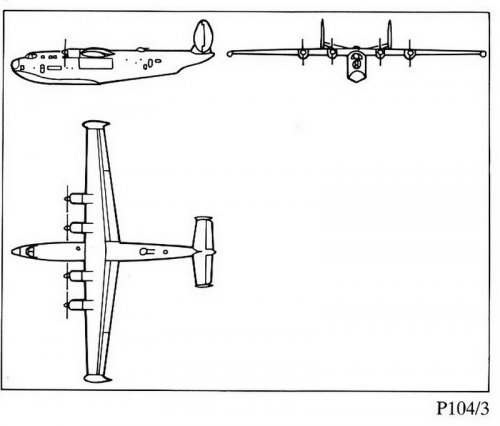Confusion: Princess (military, civil), Saro P.104, P.162, Short P.D.2.
(Here: "portly" is to mean broad beam, Sunderland-esque; "parasol" to be Catalina-esque; "slender" hull is Martin P5M Marlin-esque).
Refs: 1. Princess: www.fzt.haw-hamburg.de/pers/Scholz/dglr/hh/text_2010_06_03_SR_Princess.pdf, fr. page 51. RAF page 173.
2. Buttler/Bombers,2004, P.143: portly twin-fin, dorsal turret "VS T.524, early-1949"
3. Flight cover, 26/2/54: the same image, no dorsal turret: "Saro Ocean Patrol Concept" (elsewhere stated as Nomad/P.162)
4. (CJG) Gibson/Nimrod Genesis, P.29, portly T-tail Saro P.162/6 (after 1951; wholly different to ref 3)
5. CJG/Nimrod Genesis, p.57, portly Short P.D.2, 7/49
6. CJG/Nimrod Genesis, Pp.51/66: parasol P.D.2 (after 7/49), near-identical to:
7. CJG/Nimrod Genesis,P.49: parasol Saro P.104/1 (5/49)
8. Robunos, here, Designation Systems: Saro: 14 P.104s dated 1948-53; P.162s 1952-56.
CJG/Nimrod Genesis, P.59 has R.4/48 Sunderland replacement "won" 7/49 by portly P.104/3; not funded; parasol P.D.2 funded "by 1950".
If ref.2 is wrong (though it is credited to V-S historian
E.Morgan) and is a P.162 (so later than early-1949); and if
CJG, ref. 6, parasol P.D.2, is correct: then is this what happened?
A.Gouge designs Shetland, 1942: he prefers portly boats; MAP imposes Saro
(H.Knowler) to design the wing. MAP takesover Short, 23/3/43;
Gouge to Saro: they scheme broad beams. Pay, 1945, to put big boats with vague markings on mag. covers. Why? UK was awash in Sunderlands (inc. straight from shop to chop), averse to Mariners, Coronados.
1/11/45 new Govt. policy: BSAAC to link UK-Argentina, happy to trade in £. 1945-50 UK will swap lots - retread Magister, Sandringham,
heavens! even Prentice - for spam {yes, that's the word's origin}. Onway, more ports than airports. We need a big marine transport, even overlapping with
Brabazon Committee's Type I
Transatlantic landplane (Bristol T.167). MAP Spec. 10/46 to tender. SR.45 funded 5/46, 1 prototype+3 for BSAAC. Portly. Traditionally built, broad in the beam.
UK, no MR interest - no enemy at sea. USN 6/46 funds the new notion of slender hull, by changing Mariner to Marlin. RAE thinks about it,
Gouge/Knowler do not. CAS extracts funds, late-46, to supplement Sunderland G.R.V/Lancaster G.R.III with (to be) Shackleton M.R.1 (Tudor having failed, a prime candidate for any future
Medium Bomber needed succour).
14/4/48: Cabinet declares USSR as world-wide Threat. Bombers, fighters
awa'!...RAF marine MR Requirement out to tender; back 4/49 as portly T.524, P.D.2, P.104/3 - which, 7/49, is preferred (V-S busy, now, on (to be) Swift; V-A to help little Saro build boats apace)...ah, but...what about
our empty SB&H/Sydenham. Pause for thought.
(By 1950) Saro's slender parasol P.104/1, Marlin-inspired (USN has more such slimlines in work), ah, inspires new P.D.2, MoS trickle-funded in design. BSAAC dies, 15/3/49; BOAC (for whom MCA orders 4 Princesses, 1948) by early-49 elects to abandon marine (so, 10/11/50). SR.45 should then have been aborted...but 1/1/50 new
CAS MRAF Slessor had been AOC Coastal Command, 2/43-1/44. So, options open, SR.45 trickles on to flight 22/8/52, on MoS "Research" budget.
From 8/50, Korean War, UK basks in vast cascades of $, funding more Shackletons, loaning Neptunes. Saro pitches P.162s, Princess, Duchess variants 1952-54 to deaf ears until Cabinet, 14/1/55 says
enough already, get on with Medium Bombers. Saro into DH, 9/56, Westland, 7/59 and
Sir Arthur Gouge retires.



















